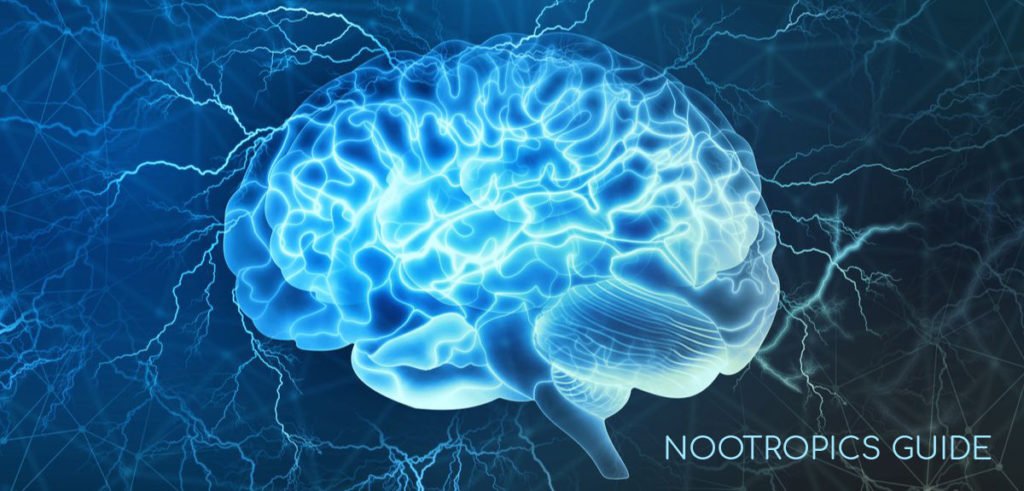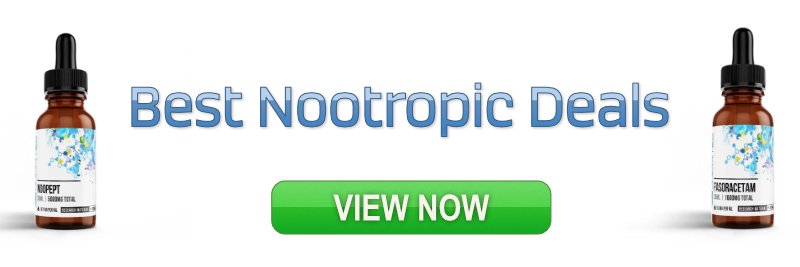
Welcome to our comprehensive nootropics A-Z list. This is a detailed overview of every major type of synthetic nootropics, natural nootropics, and supporting supplement out there. All put together into a simple alphabetic nootropics directory list. Not quite as detailed as a nootropics wiki, but far easier to see every type of smart drug and supplement on one page!
Includes basic facts about each supplement, alongside average dosage information, and links to detailed nootropics reviews for all the main types available.
NOOTROPICS – A
Acetyl L-Carnitine
Acetyl L-Carnitine, sometimes referred to as ALCAR, is a derivative of an amino acid called lysine, and is one of the minor natural nootropics out there. It’s good because it can easily cross our blood-brain barrier, making it quickly and very completely bioavailable. It’s often used as a natural nootropic, as a brain booster that has potential neuroprotective qualities, is an antioxidant, and can be a cognitive and physical energy lift. However, although it’s claimed it can ward off depression, studies have pointed to elevated levels contributing to depression. It can deliver relatively minor levels of mental improvement in verbal fluency increases, but it’s not a smart drug that will revolutionize your life.
Acetyl L-Carnitine dosage range is usually between 500 mg, and a ceiling of around 1500 mg daily.
Alpha GPC
Alpha GPC boosts Ach (Acetylcholine) levels in the brain. This is an essential neurotransmitter that helps to improve cognition, memory function, muscular control, and can potentially improve sleep patterns. It easily crosses the blood-brain barrier, and can have minor positive effects on cognition, mental focus, learning, and verbal skills. It can be gained naturally through some foods like fish, spinach, soy, and eggs. Alpha GPC can also be used as a choline source and stacked alongside nootropic drugs that deplete choline, for example like most racetams do. Not only is it one of the safest nootropics to use, but it actively minimises the side effects of choline depletion when stacked with other smart drugs.
Alpha GPC is usually taken at an average dose of around 5-600 milligrams.
Alpha-Lipoic Acid
Alpha-Lipoic Acid, or simply ALA, is a synthetic derivative of lipoic acid. This naturally occurring acid is an antioxidant that helps to increase cellular energy levels. It also thought to help eliminate free radicals that can be created from nutrients being turned into energy for the brain and body to use. Studies suggest it can boost cognitive skills, and has neuroprotective qualities. It is a very minor nootropic compound though, and is definitely classed as one of the cheapest and safest nootropics.
Average dosage ranges of Alpha-Lipoic Acid are usually around 200 mg per day, with 400 mg seeming to be a sensible ceiling.
Aniracetam
Aniracetam is a (N-chain) derivative of the original racetam Piracetam. It’s thought to be a derivative that around five times more potent. Aniracetam has a shorter half-life than most other racetams, and is fat soluble rather than water-soluble. It is a potentially potent nootropic chemical that has been shown anecdotally to reduce anxiety, lift the mood from depressive thoughts, and keeps the user alert. It’s thought to increase dopamine levels, increasing determination and focus (risk and reward behavior). Improvements in learning, cognition, plus memory creation and recall have also been noted. Some people also report enhanced perception alongside faster physical and mental response times. People say it is one of the best nootropics for studying, or focusing on important tasks.
Aniracetam is usually dosed at around 750 mg. Doses of up to 1500 mg are used by many, but this can lead to tolerance and emotional dependence in long-term use. Because it’s short half-life, many split this dose twice daily, but this can lead to problems sleeping.
Ashwagandha
Ashwaghandha has been in use for thousands of years. The name literally translates to “smell of the horse”, which has more to do with the claims that it improves mental, physical, and sexual energy levels and its physical smell. It’s been noted to induce calm, lessen fatigue, and boost cognitive abilities. It’s also classed as an adaptogen, helping to boost insulin sensitivity levels, producing antioxidant effects, and regulating blood sugar levels. It’s also a natural anti-inflammatory which can have benefits if used to calm many inflammatory conditions.
Ashwagandha is usually dosed at up to 500 mg per day as a ceiling. Low doses start at around 200 mg.
Artichoke Extract
Artichoke extract works in the brain as an inhibitor of an enzyme called PDE-4. This enzyme helps to break down cAMP molecules, which are key to brain relay signaling. By lowering levels of PDE-4 depletion, it allows higher level of cognition, wakefulness, memory formation and recall, alongside potential neuroprotective properties.
Artichoke extract is usually dosed at around 500 mg per day, and is greatly potentiated by taking it with around 5% of the total dose in Cynarin. It can be potentiated even further by combining it with Forskolin, a compound known to boost cAMP levels.
NOOTROPICS – B
Bacopa Monnieri
Bacopa Monnieri is an ancient nootropic, first mentioned in ancient Ayurvedic texts. It was originally used to help memorise long texts. It enhances cognition through lowering anxiety and improving focus. It does this through boosting dopamine levels and by improving the speed at which our central nervous system can communicate. It is an adaptogen, and these can help to lower the physical and mental signals of stress. Used for anxiety, stress relief, and as a natural antidepressant, its ability to also boost memory skills, cognition, and physical reaction times make it a fantastic all-round natural smart drug.
Bacopa Monnieri dosage is usually around 3-400 mg, although a beginner might start at 250 mg, or even 200 mg.
Berberine
Berberine is an alkaloid that is derived from various plants, but more specifically Oregon grape, goldenseal, and most usually from the Indian Barberry, which is also known as tree turmeric. Used in traditional medicine a thousand years, it has anti-microbial, anti-inflammatory, and antibacterial properties. It’s known to boost the immune system and has been used to deal with a range of ailments in natural medicine.
In terms of nootropic properties, it is one of the only natural smart drugs that can activate AMPK. This can help with any condition that affects cognition. It has a range of benefits, including helping diabetes, and regulating sugar levels. It can also improve cholesterol, improve your mood, has neuroprotective properties, lowers blood pressure, and can improve memory as well.
Berberine dosage range is usually around 500 mg, up to 3 times per day.
Black seed oil
As well as having anti-inflammatory, antibacterial, and potentially antiviral properties (which is why it’s found a resurgence in interest during the coronavirus crisis), black seed oil is also a minor nootropic oil extracted from black cumin seeds. Its main active ingredient is thymoquinine.
It’s inhibitory abilities can boost ACh production, which helps to improve learning, memory, and alertness. Anecdotally, black seed oil is said to be good for helping to reduce feelings of anxiety, which makes it fantastic to use after a nootropic should you get anxiety on the comedown.
In terms of black seed oil dosage, this is very varied. Some people advocate up to 3 teaspoons per day, but you can get capsules each containing 1000 mg which are said to be more concentrated, with around 4-6 black seed oil capsules being the equivalent of 3 teaspoons.
NOOTROPICS – C
Coluracetam
Coluracetam is a modern racetam that works through high-affinity choline uptake to produce calmness, focus, and enhanced cognitive abilities.
It is short lived and aggressive on choline supply however, but generally it is safe, well tolerated, and fantastic as a short term learning aid. Click here for a full guide to using coluracetam.
Cyclazodone
Cyclazodone is a doparminergic nootropic, developed in the 1960s and patented in 1971. It has the effects of hyperfocus, wakefulness, positive mood enducement, and higher levels of social clamness and fluency.
Click here to read a full review and guide to Cyclazodone.
NOOTROPICS – F
Fasoracetam
Fasoracetam is the newest member of the racetam family of synthezised smart drugs, mainly developed to deal with problems that they were not ever licensed for.
Fasoracetam is a well-tolerated cognitive enhancer with mild-to-no side effects in normal use. It can enhance your mental sharpness, deliver clarity of though, improved speech fluency, remove anxiety and lift your mood.
Fasoracetam works by up-regulating GABA, Glutamate, and Acetylcholine, lifting you and keeping your CNS calm while it does so.
Click here to read more about Fasoracetam.
NOOTROPICS – H
HBT-1
HBT1 is a novel AMPA receptor potentiator. Now, before your eyes glaze over, let’s break that down.
1. AMPA receptors are a type of receptor found in the brain. They play a crucial role in synaptic transmission, which is how neurons communicate with each other.
2. When we say something is an AMPA receptor potentiator, it means it enhances the function of these receptors. Think of it as giving them a little boost, like a motivational pep talk for brain cells.
Click here to read more about HBT-1.
NOOTROPICS – K
Kratom
Kratom is derived from the leaves of the kratom tree that grows across many areas of southeast Asia, including Borneo, Indonesia, and Thailand.
It can have strong effects that dictate physical energy levels, cognitive performance, happiness, and pain response. At high doses kratom can be euphoric and also deeply sedating.
You can learn more about kratom by reading our kratom guide, and the many articles on buying and using kratom that we have on the site by clicking here to discover the benefits of kratom.
NOOTROPICS – N
Noopept
Noopept is a more potent version of piracetam, although the two do not share the same chemical structure. It has strong cognitive benefits with regular use, but for single use it can be underwhelming.
Noopept has strong potential for withdrawal symptoms, and should be used with caution. Read a full guide to using Noopept here.
.
NOOTROPICS – P
Phenibut
Phenibut is a nootropic first created in the 1960s in the Soviet Union. It is still prescribed by Doctors in Russia for a range of conditions including insomnia and ADHD.
Phenibut is a potent smart drug, that can bring calmness, happiness, and cognitive focus. It influences GABA and Dopamine receptors, to deliver calmness and focus.
However, it has been found to be very easy to develop tolerance to, and brings some very painful withdrawal symptoms if exiting after regular use.
Click here to read a full guide on the good, and bad, of using Phenibut.
.
NOOTROPICS – S
SEMAX
SEMAX is a peptide (an artificial construct of a short chain amino acid), that can deliver significant nootropic benefits.
It has been linked to rapidly accelerating the effects of both Dopamine and Seratonin, bringing significant cognitive and physical benefits.
It is particularly good at enhancing perception, memory, focus, and determination, making it perfect study aid. It is short-lived though.

